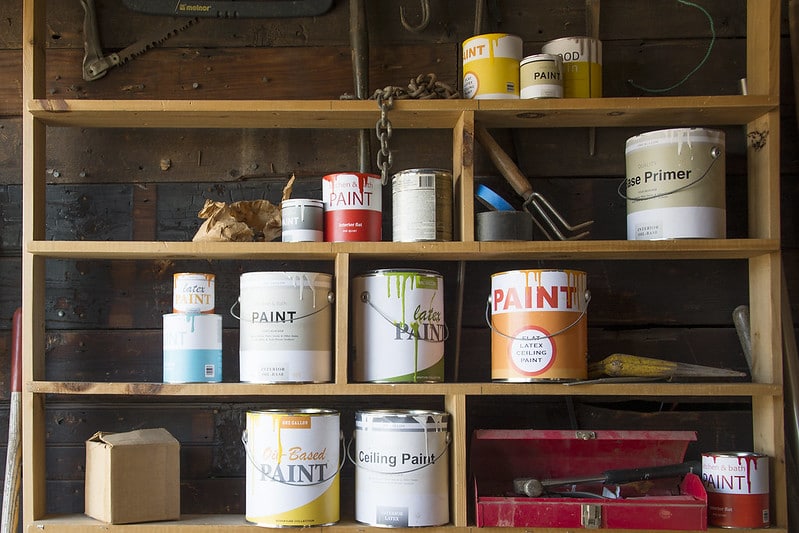
Introduction
Over the past several decades, paint manufacturers have advanced coatings technology to create more environmentally conscious and sustainable products. As a result, consumers and professionals have an abundance of safer and easier-to-use paints that deliver top quality aesthetics and durability from which to choose.
Yet leftover paint — when disposed of — is often the largest volume product collected by municipal household hazardous waste (HHW) programs: an estimated 10% of the more than 800 million gallons of architectural paint — paint used to coat the interior and exterior of houses and other structures — sold each year in the United States goes unused.
Read More…
Much, if not most of this is latex-based paint — which is considered “non-hazardous,” according to U.S. Environmental Protection Agency (EPA) testing protocols. This paint is typically managed along with other products in HHW programs as a hazardous waste, which can be very costly. In addition, management of latex paint poses a challenge for many municipalities and counties, because liquid latex paint cannot be disposed of as “mixed municipal solid waste” in the regular waste stream. However, latex paint has potential for recycling and diversion from landfills, and as such, the paint industry favors identifying leftover paint not as waste but, rather, as a product that is meant to be completely used or reused.
While leftover paint can be captured for reuse, recycling, energy recovery or safe disposal, doing so requires public awareness and a convenient and cost-effective local collection system. Many municipal, locally operated HHW programs have been collecting paint for many years; but because paint collection is expensive, many have discontinued collecting latex-based paints, instead directing the consumer to dry out and dispose of it through their regular garbage. This approach has been embraced because post-consumer paint collection is currently beyond the capacity and budget of many local governments.
But there’s a better option.
A Better Approach: PaintCare
An innovative and tested approach to manage postconsumer paint championed by the U.S. paint industry is product stewardship, commonly referred to as extended producer responsibility (EPR) — a course that is increasingly being implemented in the United States and internationally in a few industries. Domestically, post-consumer paint stewardship efforts have been spearheaded by the American Coatings Association (ACA), a voluntary, nonprofit trade association working to advance the needs of the U.S. paint and coatings industry. ACA created PaintCare, a 501(c)(3) organization whose sole purpose is to ensure effective operation and efficient administration of paint stewardship programs, on behalf of all architectural paint manufacturers in the United States.
Read More…
Working within the hierarchy of “reduce, reuse, recycle,” PaintCare undertakes responsibility for ensuring an environmentally sound and cost-effective program, reducing the generation of post-consumer architectural paint; promoting its reuse; and providing for its collection, transport, and processing.
This Issue Backgrounder details all facets of the PaintCare program — a true product stewardship model that ensures environmentally sensitive end-of-life management for leftover paint, while relieving local and state governments of their economic burden without creating new, expensive local or state-run programs.
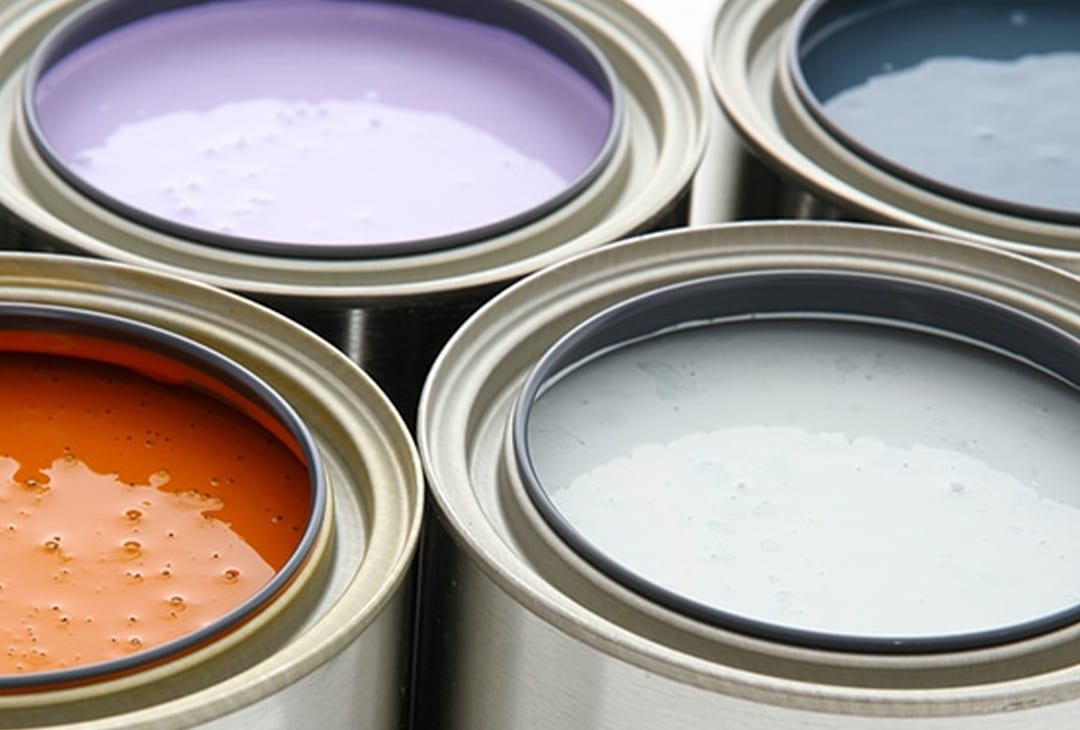
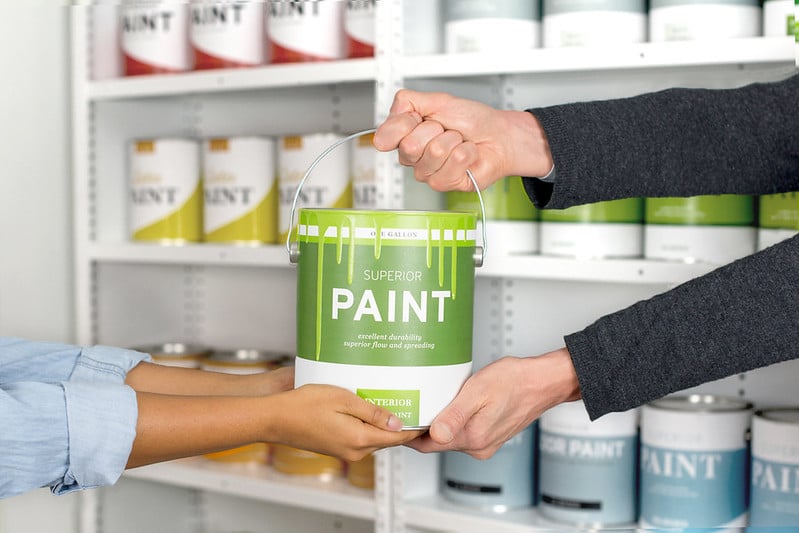
PaintCare: A Leader in Product Stewardship
Instead of shifting the cost burden from the government to producers, product stewardship is a principle that directs all participants involved in the life cycle of a product to take shared responsibility for the impacts to human health and the natural environment that result from the production, use, and end-of-life management of the product. EPR principles assert that it is in the best interest of state and local governments that manufacturers manage environmentally sound and cost-effective end-of-life stewardship programs for their products.
Read More…
These terms, ‘extended producer responsibility’ and ‘product stewardship’ — often used interchangeably — allow a reduction of overall system costs by privatizing the end-of-life management for products and shifting the cost burden from taxpayers to users and producers of the products.
All participants in the life cycle of a product have a role to play — manufacturers, retailers, consumers, and government. However, if producers are going to have the primary responsibility for the end-of-life management of their products, they must be given the ability to develop, own and operate the programs — and not simply be forced to fund current programs.
After more than five years of promoting a model solution for post-consumer paint management, ACA was instrumental in securing passage of the first-ever paint stewardship law in the United States in the state of Oregon in July 2009. Since then, ACA has sponsored and successfully passed parallel legislation to establish the PaintCare program in California, Colorado, Connecticut, District of Columbia, Maine, Minnesota, Oregon, Rode Island, Vermont, Washington, and most recently, New York, with program operations that launched May 1, 2022. Once the legislation
is passed, PaintCare develops an industry-led, end-of-life management program for post-consumer architectural paint — both oil-based and latex paint, sold in containers of five gallons or less, used for the interior and exterior of buildings. PaintCare was developed as part of an agreement with federal, state, and local government stakeholders.1
The PaintCare Legislative Model
In Oregon, House Bill 3037 created the first-ever paint stewardship program in the United States, which began operations in July 2010. The legislation enables the industry to implement the program; provides for a level playing field among manufacturers and retailers; and establishes a sustainable financing system. The Oregon bill became the model for subsequent PaintCare state legislation. A key element of the legislation is that all producers and retailers selling paint in the state must participate in the program.
Read More…
A key element of the legislation is that all producers and retailers selling paint in the state must participate in the program. While ACA continues to provide advocacy for the program, PaintCare represents architectural paint manufacturers in implementing the program and is open to all architectural paint manufacturers — producers do not have to be ACA members for PaintCare to act as their stewardship organization.
The financing system is termed a “paint stewardship assessment.” This assessment, also called the PaintCare fee, is paid to PaintCare by producers for all architectural paint sold in a state where the program is operating. Under the law, it must be added to the wholesale price of paint for all distributors and retailers and included in the final purchase price of paint for all consumers in the state. This financing system is a consumer cost-recovery model like the Product Care program, an established product stewardship organization running similar programs for paint in Canada for over 30 years.
The legislation also provides important protection for manufacturers and retailers, a limited antitrust exemption for activities pursuant to the program. Most notable among these is the financing system, allowing competitors to come together for the purpose of the program and establish the assessment on their products uniformly.
Funding for PaintCare
Funding covers all operational aspects of the program — collection, paint bins, transportation, recycling and other processing, public outreach and education, and administrative costs. Importantly, ACA and PaintCare, while affiliated organizations, have separate financial records — compensation and expense for ACA’s advocacy on behalf of the organization do not come from the assessment, but rather ACA member dues. PaintCare submits a comprehensive plan to the requisite state agency on behalf of paint manufacturers, which details these costs and outlines how PaintCare will set up and run a convenient, statewide system for the collection of post-consumer architectural paint and the management of its end-of-product-life that is reuse, recycling, energy recovery, and proper disposal.
PaintCare financing and budget submitted to the state agency is used to educate consumers about the issue: reducing post-consumer paint waste, collection, recycling opportunities, and how the program is financed. Finally, the model legislation requires yearly reporting to the state agency on the progress of the program and any changes necessary, which PaintCare also undertakes on behalf of its producer participants. These reports include how much paint was collected, the method of recycling and an independent financial audit of the program. All PaintCare program annual reports are publicly available on the PaintCare website.
Currently, some 186 manufacturers participate in PaintCare. Manufacturers remit the PaintCare fee to PaintCare for every container of architectural paint sold in the state that is larger than a half pint and up to 5-gallons in size. The fees are set at levels to cover the costs specific to each state program, though an effort is made to use similar fee structures when possible. The fee varies by state and container size, ranging from $0.35 to $1.99 per container. A higher fee may be due to one or more reasons, including higher rates of returned leftover paint or higher vendor pricing.
This nominal fee not only covers the costs of collecting, transporting, and recycling, or properly disposing of recently purchased paint, it also covers these costs for old, leftover paint that residents already have in their basements and garages. Moreover, PaintCare ensures that consumers now have better education on the issue of post-consumer paint management and transparency about the financing of the program. The law mandates that consumers be informed that funding for the operation of the paint stewardship program has been added to the purchase price of all architectural paint sold in the state and what services that entails. To further ensure fairness, consumer protection, and transparency, the legislation specifies that the assessment funding the program must be approved by the state agency as part of the program plan and must be sufficient to cover, but not exceed, the costs of the program.
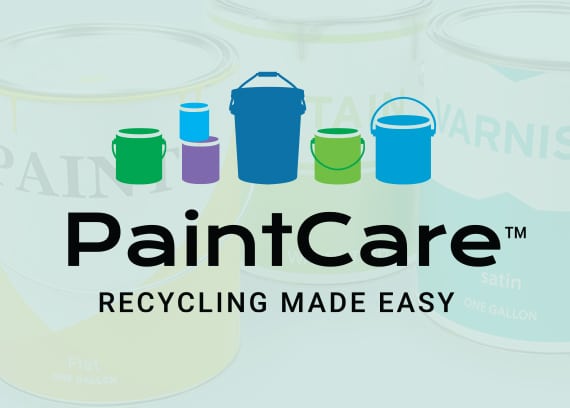
PaintCare Successes & Milestones
As mentioned above, 11 jurisdictions — 10 states and the District of Columbia — have enacted legislation to establish the PaintCare program. All these states now have a PaintCare program. PaintCare has had remarkable success since its inception. In fact, the Oregon program was only intended to be a four-year pilot, but due to its incontrovertible success, the PaintCare program was made permanent by law in 2013.
In its 11 years of operation, PaintCare boasts the following achievements.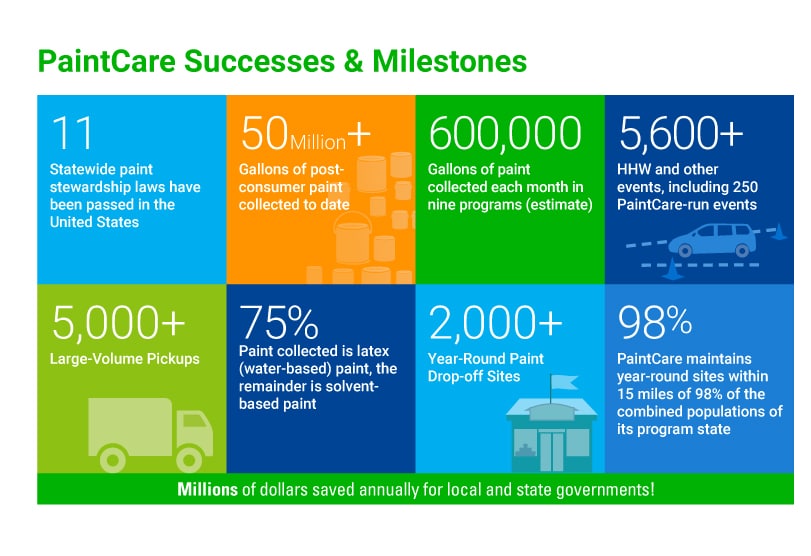 Overall, paint recycling is now more convenient throughout the states in which PaintCare operates, particularly in areas where local governments do not offer paint recycling opportunities; governments that previously collected leftover paint are realizing direct financial savings; and communities that were underserved have new services.
Overall, paint recycling is now more convenient throughout the states in which PaintCare operates, particularly in areas where local governments do not offer paint recycling opportunities; governments that previously collected leftover paint are realizing direct financial savings; and communities that were underserved have new services.
See state milestones by visiting the state tabs on www.paintcare.org.
PaintCare’s EPR Efficiency Extends to Container Recycling
ACA and the paint industry are leaders in the EPR space with their vanguard PaintCare program, a true product stewardship model that ensures environmentally responsible end-of-life management for leftover paint — and where possible, its packaging — while relieving local and state governments of their economic burden without creating new, expensive local or state-run programs. PaintCare is an industry-run program with more than 12 years’ experience of successfully diverting waste from landfills and recycling in both an efficient and cost-effective manner. Notably, this includes container recycling for both plastic and metal containers, where state infrastructure is in place to allow that.
Read More…
In 2020, across nine states and the District of Columbia where PaintCare was running, the program recycled approximately 3,789 tons of metal and plastic containers.2
This is notable because new and varied EPR proposals in many states are seeking to require producers to manage the end-of-life of products introduced into commerce, including the products’ packaging as a means of reducing the packaging waste stream and shifting the cost burden from state government to industry. Where the paint industry has PaintCare program operations, PaintCare recycles as many product containers as it can but is limited by state recycling capacity. Downstream paint processors and HHW programs send empty metal and plastic paint containers for recycling when possible; but commodity market conditions have an impact on the extent to which container recycling is feasible, as does the state infrastructure to support the volume of recyclable containers.
As such, ACA is acting to ensure that PaintCare’s work is properly recognized so that it can maintain its role in steering and managing its industry-run EPR program. This would effectively acknowledge and continue the PaintCare environmental stewardship success, without a shift to government-run EPR, and without the additional onus of new fees on industry. By way of example, because of PaintCare’s longstanding programs in both Maine and Oregon, those states enacted EPR packaging laws that provided exemptions for containers for architectural paint subject to a paint stewardship program. ACA advocated that exemption language be incorporated because barring incorporation of that language, those bills would have both imposed significant fees on paint manufacturers, and ultimately consumers, that already pay fees to PaintCare for recycling in existing programs.
ACA is eager to grow its landmark PaintCare stewardship program in the 11 jurisdictions where the program has been adopted — as well as broaden adoption of the program to more states. At the same time, ACA maintains that it is critical that divergent EPR proposals arising across the states recognize the work conducted by product stewardship organizations like PaintCare and do not impose undue regulatory or financial burdens on industry. Any new EPR measures related to product packaging/containers should provide PaintCare an exemption from a new EPR system, since PaintCare is already undertaking that responsibility. Doing so will allow industry and PaintCare to keep their fees as low as possible to encourage consumers and businesses to participate in the program.
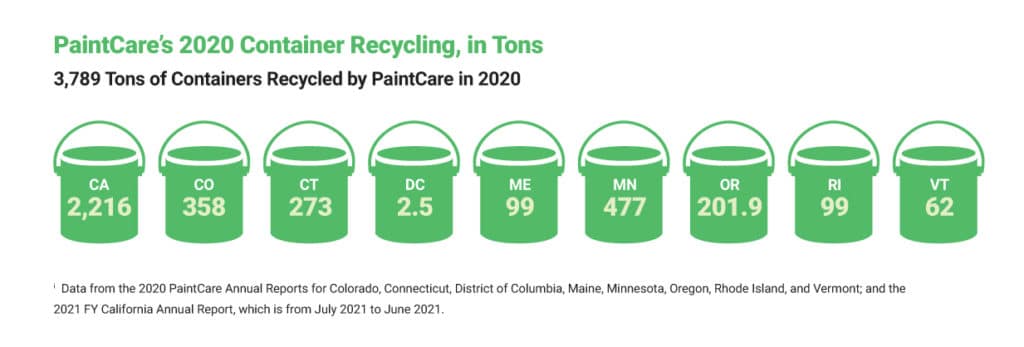
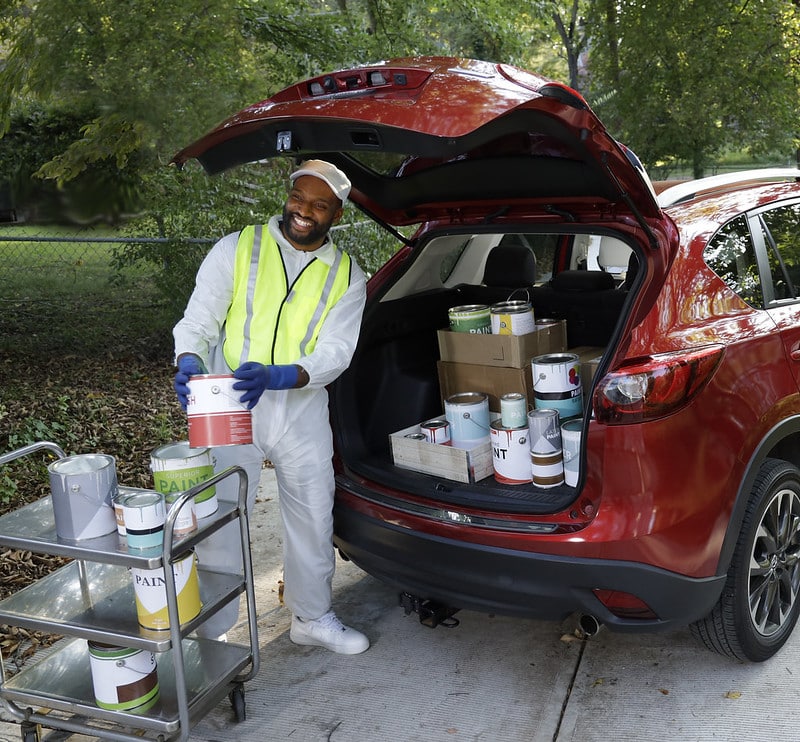

Growing Across the Country
The PaintCare program is designed to provide collection and recycling opportunities for both consumers who have not had access to collection and recycling services, particularly for latex paint, as well as those who have had to pay additional fees for such services, such as contractors and other professionals.
And the benefits of PaintCare extend beyond those who can drop off leftover paint: PaintCare saves state and local governments money by reducing the HHW collection burden borne by municipalities.
Read More
As such, many state governments are carefully tracking PaintCare’s success, throughout the states in which it is operating, with an eye toward adopting it. PaintCare legislation is currently pending or being considered in Maryland, New Jersey, Massachusetts, and Illinois.
Substantial commitment and resources are required to draft and enact paint stewardship legislation, including identifying bill sponsors and building support among legislators and other stakeholders within the timeframe of a legislative calendar. As stated above, ACA fulfills its role as the advocacy organization and funding for such comes from ACA member dues — not PaintCare revenue. Substantial commitment and resources are also required to design and implement paint stewardship programs, including developing stewardship plans in coordination with the state agency; establishing an appropriate collection infrastructure; engaging retailers, local governments, and consumers to build support; and developing a public education program targeted to paint consumer audiences. ACA works with local municipal HHW programs, recycling organizations, haulers and recyclers, local product stewardship organizations, county councils, and the agency overseeing environmental programs in the state to bring the program to fruition. PaintCare fulfills its role as the nonprofit services organization and is intended to serve as the nationally coordinated system for managing leftover paint.
To reiterate, PaintCare revenue is collected for each state based on the sales of architectural paint manufacturers in that state, and the revenue is specific to and stays with that state. ACA’s goal is to pass the legislation in any state interested in the program. The goal of PaintCare is to reduce paint waste, while establishing mechanisms for efficient collection, reuse, recycling, and proper disposal of leftover paint. ACA and PaintCare are committed to providing the most effective program for paint stewardship, learning from its growing body of experience in 11 states, and developing new statewide programs on behalf of the paint and coatings industry.
ACA is eager to bring PaintCare to any state interested in the program. Let’s start that conversation.
Learn more about the PaintCare program at www.paintcare.org, or
CONTACT
For more information on the paint and coatings industry, contact ACA’s Vice President of Government Affairs Heidi McAuliffe at hmcauliffe@paint.org.
1 PaintCare was developed over the course of many years through the Paint Product Stewardship Initiative (PPSI) dialogue initiated by the Product Stewardship Institute (PSI). By the time the PPSI concluded in 2008, ACA, five paint manufacturers, eight state governments, 31 local government agencies, and several other related businesses and organizations had agreed to and signed two Memorandums of Understanding (MOUs) relative to the core elements of the program. This dialogue was collaborative, facilitated by PSI, and PaintCare is the result.
2 Data from the 2020 PaintCare Annual Reports for Colorado, Connecticut, District of Columbia, Maine, Minnesota, Oregon, Rhode Island, and Vermont; and the 2021 FY California Annual Report, which is from July 2021 to June 2021.